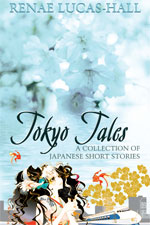
In celebration of the cherry blossom season in Japan, here’s a slightly steamy true story about love, passion, feelings, and the transient nature of life titled “Sakura 桜 (Cherry Blossoms)” by Don MacLaren, an accomplished writer and Japanologist.
MacLaren spent many years living and working in Japan. His understanding of the way Japanese people think and behave and his affinity with the Japanese culture is clear and evident in this compelling short story, originally published in ‘The Write Place at the Write Time’ literary magazine in spring, 2010.
Find out more about Don MacLaren at the end of this story. He has led and continues to lead a fascinating life!
SAKURA 桜 (CHERRY BLOSSOMS) — A STORY BY DON MACLAREN
In the early ‘90s, after over two years in Japan teaching English, intensely studying Japanese, karate, and paying off large debts in the form of student loans and credit cards, I fell in love with a woman I’d been teaching. She kept taking my classes, and later began calling me up, inviting me to concerts, and then offering to take me to a store that sold Chinese herbal medicine, where she said I could get something that would help heal the allergies that sometimes plagued me in Japan.
For a year or so, I ignored her entreaties but she persisted and one day in March 1993 she came to my apartment. I cooked lunch for her and we sat down on the tatami-covered floor and talked. Later, standing up to look at the map of Japan on my wall, she pointed out the place on the Izu Peninsula, south of Tokyo, where she and her mother had gone to an onsen (a hot spring) a year earlier. As we stood next to each other I reached for her and we embraced, then gradually descended to the tatami-covered floor, where we kissed and melted into each other. Raindrops splattered gently against the window as I felt her heart thumping hard inside her chest.
We recounted our life stories to each other that day as we lay on the tatami. She began coming over regularly and we made love through several long, humid summer afternoons.
As she told me that she’d worked in a Shinto shrine for a time before I’d come to Japan, I’ll call her Ms. Shinto.
*
In Japan there are many layers of reality. There is the tatemae surface reality and there is the polar opposite, the honne “true reality.” But there are several layers in between as well, which include several aspects of one’s will between giri (following society’s dictates) and ninjo (following the feelings of one’s heart). Some compare Japan to an onion: the more you peel it the more layers you find, but Japan is also like a woman in a kimono.
There is not only the aesthetic surface layer of the kimono that the outside world sees; there are several layers between that surface layer and the skin. Kimono dressing, called kitsuke in Japanese, is an art and a craft like calligraphy or ikebana (flower arranging), and many Japanese women spend years perfecting the craft of dressing oneself and others in all the layers of kimono. One of the practitioners of kitsuke was Ms. Shinto.
*
At that time I was the only man Ms. Shinto loved, and she was the only woman I loved. But there was a problem. She was engaged to another man – a fact I had known about before she had come to my apartment and one of the reasons I had been hesitant to meet her outside of school. Initially, when my mind turned away from thoughts of passion and flesh to thoughts of morals and ethics, I thought that being with her was wrong. Not only would it hurt her fiancé if he knew about Ms. Shinto and I, but it was bound to hurt me in the long run as well, because I was bound to lose her. However, as time went by and she and I continued to see each other, I concluded that what was really wrong was that she was going to marry someone she didn’t love. What was morally and ethically right was for us to fall in love, and if she decided she didn’t want to marry a man that her parents and her fiancé’s parents had decided she must marry, then so much the better. She was going through a similar psychological quandary as I, and told me she had refused any physical intimacy with her fiancé since the time she and I had first kissed.
I decided that I wanted her all to myself or not at all. Since she told me she didn’t have any desire to get married and that if given a choice she would marry me, I decided I had to do the right thing – for me, for her, and for her fiancé. I told her that either she had to leave her fiancé or I was going to leave her. And as an alternative to marrying him, I suggested she marry me.
About a month after I gave her that ultimatum she came to visit me and told me, while chain-smoking, with tears in her light-brown eyes, that she had no choice but to marry her fiancé. She also told me that she was going to have the formal Japanese engagement ceremony, called the konyaku, between herself, her fiancé, and their two families a few weeks hence (though Ms. Shinto, her fiancé and their families had verbally agreed to the marriage months before).
After she and I had fallen in love, she had tried to put the konyaku off, but the pressure from her fiancé and both their families was too great; they refused to allow her to defer or delay.
“I’m sorry,” she said, and left, brushing her shoulder-length light brown hair from her face. Once she’d closed the door, I heated a small porcelain container of sake – despite the fact that it was a hot and humid, stormy evening – sat down on the tatami, slowly drank it, then went to sleep.
In the end giri won over ninjo and so it was that Ms. Shinto married a man she did not love.
*
It was my experience in Japan that people would come close to me for a short time, disappear, and then pop up again months or years later without notice. Worse still, they would sometimes then disappear forever as do the sakura (cherry blossom) petals after a spring rain in Japan, which brings me to another woman I’ll write about. I’ll call her Ms. Shinjuku, because I first met her in person in Tokyo’s Shinjuku district at a bookstore I frequented.
*
After a little over a year and a half in Japan I saw an ad in The Japan Times for Japanese lessons by phone which I decided to sign up for, since I was planning to take a Japanese language proficiency test given by the Japanese government. I called up the number and was assigned a teacher who lived in Tokyo – about 70 kilometers south of where I was living at the time. I took the test in December 1992, and after the test my teacher, Ms. Shinjuku, met me at the bookstore and we ate at a restaurant nearby.
A couple of months afterwards I saw her off to Taiwan, where she was going to study Mandarin Chinese.
A year and a half or so later, I received a call from Ms. Shinjuku. She told me she was in the hospital and said she wanted to see me.
The first chance I had to see Ms. Shinjuku after her return from Taiwan was in March 1995, when I went to Tokyo to renew my visa. After getting my passport stamped with a one-year visa extension, I visited Ms. Shinjuku in the hospital. She was a shell of the woman I had seen earlier and looked near death. She had looked just slightly overweight when I had last seen her, but she was close to skeletal in the hospital. Her brown eyes were cloudy as they peered at me above an oxygen mask that covered her face. In those eyes I saw both the fragility and the sacredness of life. I felt compelled to be with her and care for her till her life was over, which I thought would be soon. As I was about to leave I gently caressed the side of her face, then walking outside couldn’t help but cry – trying, mostly unsuccessfully, to hide my tears all the way home on the train.
Ms. Shinjuku and I exchanged letters, and I saw her several other times in the hospital. On one of those visits she told me she had epilepsy, and that after seizures she was periodically hospitalized.
I called her several times, but we only met once or twice. After recuperating from one epileptic seizure she worked as an actress in a couple of television shows.
I tried to meet her a few times, but she was always busy, and from her tone in our phone conversations I assumed she had a boyfriend. In any case, I became busy myself with other matters, started writing a novel and lost contact with her. However, on New Year’s Day 2000, after a three-year hiatus in communication, I received a New Year’s card from Ms. Shinjuku. “Call me!” she had written in English at the bottom of it, below a short message in Japanese. A couple of days later I did.
In mid-January, we met and had lunch. This time, we continued to talk for a few hours. Ms. Shinjuku listened to the matters that weighed heavily on my mind. I was relieved to have found a Japanese friend who, in contrast to many others I knew, really seemed to care about me – on a sincere honne level, rather than on a superficial tatemae one. On the way back to the train station I put my arm around her. She reciprocated. We kissed and parted. With that one kiss I transcended the despair and frustration I had been living in for the last several months. But unbeknownst to me I had gotten lost in the kimono layers of reality, trapped inside the onion. Was it giri or was it ninjo? Was it tatemae or was it honne?
Whatever it was I was mistaken.
I tried calling her several times after that, but she didn’t answer. I wrote her a letter in Japanese a couple days after meeting her, but still got no response. Valentine’s Day came and went without a letter from her. I then wrote her more letters in Japanese. I was thinking that perhaps, because of my limited ability in expressing myself in Japanese that I had made some mistake, and had given her the wrong signal by accident, but I was also sure that if she really cared about me that she would contact me.
After several more attempts at making contact I finally got through to her answering machine when I tried to call her. (Each time I had called before I had gotten a busy signal.) I told her answering machine I was in love with her and waited for a response. None came. Over a week went by and I couldn’t stand the waiting so I then sent her another letter. I felt as if every cell in my body was breaking up, as if the core of my being were falling apart. I felt as if lost inside the layers of the kimono of a goddess who had put a curse on me. I told her that if she wanted to see me again to write me by the time the sakura had stopped falling. It was early March at that time, and the sakura had not yet even begun to bloom so I figured that gave her at least a month.
The day I sent her the last letter was the first day of the year that truly felt like spring, and I could smell the fecundity of nature all around as I spent that night walking through a large park near my apartment, exploring every corner of it. I cried as I thought of her… and I continued to cry for weeks, sometimes having to hide my face at work as the tears began to flow.
When we met in January she had told me that she had “died” in the hospital about six months earlier, having an out of body experience, but coming back to life. I felt as if I were about to die as well.
For some reason fate had brought Ms. Shinjuku and I together, but in the end fate was cruel. I was destined to travel the rest of my time on earth without seeing her again, without any explanation from her as to why she had chosen to abandon me. It’s funny that the times like that, when I felt closest to death, were the times that the tears and the pain in my heart made me feel I was most alive as well.
The sakura fell on me as I walked through the park and the sky was clear, but Ms. Shinjuku might as well have been in some fantasyland, beyond the stars I saw in the sky, for she was gone with the falling of the sakura, never to return.
I left Japan, took an 18-day trip through Europe and moved to New York City.
Years later, after I had found a different and more faithful Japanese woman, I received a letter from Ms. Shinto. Opening it, I was hoping to find she had come to terms with her life and was happy, but in the letter, written in Japanese, she told me that though she had given birth to two children, her lack of feeling toward her husband had not changed in the many years since we had lain on the tatami with each other in my old apartment.
Not long ago I returned to Japan and walked through the same park the cherry blossoms had fallen on me when Ms. Shinjuku had disappeared from my life. Many Japanese are buried under cherry trees – after having committed ritual suicide as part of giri.
Leaning against one of the cherry trees I felt a combination of melancholy and joy, a love both bitter and sweet, like all the loves I have known. And I know that despite their bittersweet quality, they have all made me a richer human being. In spite of the way the sakura petals fall all too quickly from their trees, they never fail to bloom again.
Copyright © by Don MacLaren

Don MacLaren’s writing has appeared in numerous publications such as Haight Ashbury Literary Journal, The Japan Times, TIME and Wilderness House Literary Review. He has recently completed a memoir about his years as an expatriate, which will be published at a date to be announced.
Since leaving the US Midwest when he was 19, MacLaren has spent time in over 20 countries, as well as 45 US states. He lived in Japan for 11 years, working as a writer, translator and teacher.
Since 2015, MacLaren has been teaching academic writing, public speaking and US history in a college-preparatory program in Jiangsu Province, China. His students and former students have been accepted to or are now going to schools such as Brandeis, New York University, Rutgers, UC Santa Barbara and the University of Wisconsin at Madison.
You can follow Don on Twitter and learn more about him at donmaclaren.com











